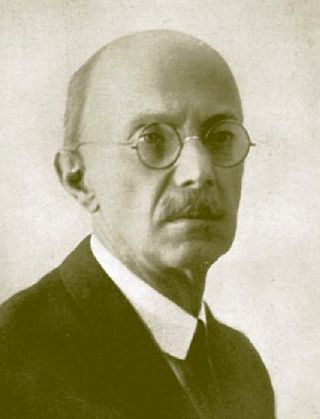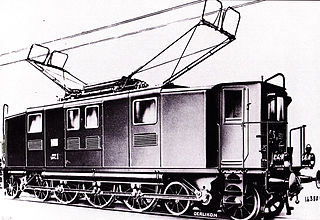This article needs additional citations for verification .(February 2018) |
| Class E.380 | |||||||||||||||||
|---|---|---|---|---|---|---|---|---|---|---|---|---|---|---|---|---|---|
 | |||||||||||||||||
| |||||||||||||||||
| |||||||||||||||||
| |||||||||||||||||
| |||||||||||||||||
The FS Class E.380 was a small class of three-phase electric locomotive used in Italy, introduced in the 1900s.
This article needs additional citations for verification .(February 2018) |
| Class E.380 | |||||||||||||||||
|---|---|---|---|---|---|---|---|---|---|---|---|---|---|---|---|---|---|
 | |||||||||||||||||
| |||||||||||||||||
| |||||||||||||||||
| |||||||||||||||||
| |||||||||||||||||
The FS Class E.380 was a small class of three-phase electric locomotive used in Italy, introduced in the 1900s.
The locomotives, which entered in service in a small batch of 4 units, were characterized by a central cabin with two large hoods at each end. Built by Ganz, they had a similar mechanical equipment to the E.360 type. The E.380s showed a series of problems, so that two were refurbished as E.390.
The two fixed speeds were obtained by changing the motor connections. For high speed the motors were connected in parallel. For low speed the two motors were "cascaded" by connecting the rotor of one motor to the stator of the other. This caused both motors to run at half speed. [1]
The low power output at the highest speed, and the limitation of use to only two fixed speeds (due to the control arrangement of the three-phase motors) led both classes to be retired after a short service period.

A locomotive or engine is a rail transport vehicle that provides the motive power for a train. If a locomotive is capable of carrying a payload, it is usually rather referred to as a multiple unit, motor coach, railcar or power car; the use of these self-propelled vehicles is increasingly common for passenger trains, but rare for freight.

An electric locomotive is a locomotive powered by electricity from overhead lines, a third rail or on-board energy storage such as a battery or a supercapacitor. Locomotives with on-board fuelled prime movers, such as diesel engines or gas turbines, are classed as diesel-electric or gas turbine-electric and not as electric locomotives, because the electric generator/motor combination serves only as a power transmission system.

Kálmán Kandó de Egerfarmos et Sztregova was a Hungarian engineer, the inventor of phase converter and a pioneer in the development of AC electric railway traction.

An articulated locomotive is a steam locomotive with one or more engine units that can move independent of the main frame. Articulation allows the operation of locomotives that would otherwise be too large to negotiate a railroad's curves, whether mainlines or special lines with extreme curvature such as logging, industrial, or mountain railways.

In rail transport, head-end power (HEP), also known as electric train supply (ETS), is the electrical power distribution system on a passenger train. The power source, usually a locomotive at the front or 'head' of a train, provides the electricity used for heating, lighting, electrical and other 'hotel' needs. The maritime equivalent is hotel electric power. A successful attempt by the London, Brighton and South Coast Railway in October 1881 to light the passenger cars on the London to Brighton route heralded the beginning of using electricity to light trains in the world.

The E.412 class is a batch of multi-role electric locomotives built for the mountain lines, particularly for the northern Italian lines of the Brenner pass. They are known as Brenner or Brennerlok locomotives. 28 units from both the groups have been acquired by Trenitalia, as part of a process of simplifying rail operation between Italy, Switzerland, Austria and Germany. The locomotives are qualified for running on French rails, too, making the E.412s potentially fit for service on most European lines except the high-speed rail lines.

The FS E.636 is a class of Italian articulated electric locomotives. They were introduced in the course of the 1940s until the 1960s, and have been decommissioned since 2006. They have been one of the most numerous Italian locomotive groups, and have been widely employed during their long career, hauling every type of train, ranging from freight to long range passenger services. Their introduction also saw the employment of some revolutionary design concepts, such as the articulated carbody and the three bogies scheme.

The Deutsche Reichsbahn-Gesellschaft (DRG) Class E 18 is a class of electric locomotives built in Germany and Austria between 1935 and 1955. With exception of Class E 19 it was Deutsche Reichsbahn's fastest electric locomotive. After 1945 most of the surviving locomotives were operated by Deutsche Bundesbahn (DB), although a few passed to Deutsche Reichsbahn (DR) and Österreichische Bundesbahnen (ÖBB).

E.402A/B is a class of electric locomotives mainly used on medium speed passenger trains by the Italian railway company FS Trenitalia.

The FS Class E.550 was a class of three-phase electric locomotive used in Italy, introduced in the 20th century, which remained in service until 1965.

Three-phase AC railway electrification was used in Italy, Switzerland and the United States in the early twentieth century. Italy was the major user, from 1901 until 1976, although lines through two tunnels also used the system; the Simplon Tunnel between Switzerland and Italy from 1906 to 1930, and the Cascade Tunnel of the Great Northern Railway in the United States from 1909 to 1939. The first standard gauge line was in Switzerland, from Burgdorf to Thun, from 1899 to 1933.

The Ferrovie dello Stato Italiane Class 600, formerly Rete Adriatica Class 380 and Società per le Strade Ferrate Meridionali Class 380, is a 2-6-0 'Mogul' steam locomotive; it is considered by some as the first Italian modern steam locomotive.

The BB 13000 class were electric locomotives operated by SNCF in France. They were one of four classes, together with the BB 12000, CC 14000 and CC 14100 classes, that formed an experimental group for studying the practicality of the new French 25 kV 50 Hz AC electrification.
The FS Class E.470 was an electric locomotive class of the state-owned Italian railway Ferrovie dello Stato. It was used on the Italian three-phase test line from Rome-Sulmona especially in express train service. After the end of the trial operation in 1945, the locomotives were scrapped, and no locomotive of the class has been preserved.

The FS Class E.431 was a class of three-phase AC electric locomotives of the Italian State Railways (FS).

FS Class E.432 was a class of three-phase electric locomotives of the Italian State Railways. Forty of these 1′D1′ locomotives were built in 1928 by Società Ernesto Breda and two have been preserved.

FS Class E.331 was a class of three-phase electric locomotives of the Italian State Railways. Eighteen of these 2′C2′ locomotives were built between 1914 and 1919 by Breda and Brown-Boveri.

FS Class E.332 was a class of three-phase electric locomotives of the Italian State Railways (FS). They were used for the haulage of passenger trains between 1917 and 1963. Designed and built at the same time as the FS Class E.331, they represented an attempt by FS to extend the use of three-phase AC electric traction from primary to secondary routes. Their performance was disappointing and they were relegated to a marginal role, in which they remained despite several modifications.

FS Class E.333 was a class of electric locomotives of the Ferrovie dello Stato (FS), powered by three-phase alternating current, which were in service from 1923 to 1968. They were designed by Kálmán Kandó for hauling fast passenger trains. Having the same electrical equipment as the FS Class E.552 locomotives, they presented the same defects and had to be modified. After modification, they were able to carry out the services for which they were designed.

Rigid-framed electric locomotives were some of the first generations of electric locomotive design. When these began the traction motors of these early locomotives, particularly with AC motors, were too large and heavy to be mounted directly to the axles and so were carried on the frame. One of the initial simplest wheel arrangements for a mainline electric locomotive, from around 1900, was the 1′C1′ arrangement, in UIC classification.